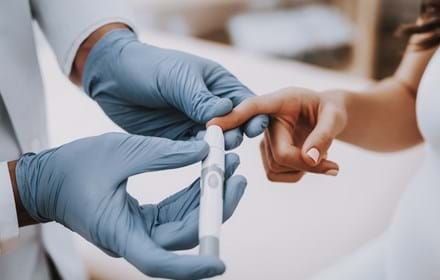
Focus on the interaction between healthcare professionals and people living with diabetes in accessing vital services
Read Day Five of DRWF Research Manager Dr Eleanor Kennedy’s blog reports from the Diabetes UK Professional Conference.
The virtual format for this event is not the same from attending in person, as I said in one of my earlier blogs from this week. I sincerely hope that virtual conferences do not become the new norm. However, as I log onto the platform for Day Five, there are a surprising number of people registered for each of the sessions and I try to imagine what this would look like in a filled auditorium in Glasgow!
The last day of the first week is really dominated by one prize lecture. The Mary MacKinnon Lecture. This award is given to a diabetes team working collaboratively to provide integrated person-centred care in the community and, this year, the lecture entitled Shaping the future of diabetes care: Innovation, people and partnerships is by Dr Neel Badusev.
Future of diabetes care and making the system easier to navigate
Working in South London, the area that care needs to cover seamlessly is vast – a population of 3.3 million of which 167,000 people are registered with type 2 diabetes, a further 12,000 registered with type 1 diabetes, 275,000 with non-diabetes-related hyperglycaemia (high blood glucose levels) and 32% of residents of black, Asian or mixed ethnicity backgrounds and 12% who do not speak English at home. The challenges are similarly vast.
One of the initiatives discussed was to use a joint practise-based clinic system, nurse-led consultations given every two to three months with a consultant visit every six months. Advice was given in practice allowing the team to manage people with more complex conditions, thus preventing referral to specialist care. In these multidisciplinary clinics, there were much fewer patient referrals, and an example of a key achievement was that, between June 2014 and April 2016, insulin pump uptake increased from 8.8% to 11.9% in south London.
Thanks to funding from the Diabetes Transformation initiative, the group were also able to set up another scheme, Diabetes Book & Learn. As Dr Badusev said, structured education is a good thing, but not enough people are doing it! So, with input from a number of different stakeholders including, importantly, patients, they were able to make the system easier to navigate and accessible for healthcare professionals and patients alike.
Interestingly, the ability to view structured education in areas other than one’s home area via the Diabetes Book & Learn website encouraged about 30% of people to travel to a face-to-face structured education course elsewhere certainly in the pre-Covid-19 era when such travel was permitted. Whilst 54% stayed within their home area for a face-to-face education event, 17% sought the information digitally and remotely. However, this was not the only point of interest with this initiative.

Importance of communication between healthcare professionals and people living with diabetes
To improve uptake, they needed to consider how healthcare professionals in primary care communicate with patients on the subject of structured diabetes education. The attitude of the healthcare professional is key. Many of the non-attenders had a lack of information or a poor perceived benefit of the programme whilst many of the attenders have received positive messaging from their healthcare team.
The team also looked at how to improve the lives of young people with type 1 diabetes - with their Youth Empowerment Skills initiative. This demonstrated that this group wanted to learn more about their general health, how to adapt to a life with type 1 diabetes and how to communicate with friends and families about heir condition. They wanted to learn from and listen to other young people with type 1 diabetes, but definitely not in a hospital setting!
The results demonstrated the success of undertaking this course – in the year subsequent to participating in this course, HbA1c levels were decreased, as were hospital admissions for hypoglycaemia or for diabetic ketoacidosis.
Dr Badusev then switched focus to talk about the changing workforce in primary care.
According to the National GP Worklife Survey, two out of every five GPs intend to quit in the next five years. And whilst the number of GPs fell by 1.6% over the 12 months to September 2018, other direct care staff working in general practice such as dispensers, pharmacists, phlebotomists, and healthcare assistants rose by 5.5% pointing to a change in the mix of staff working in general practice. The healthcare service in England currently has more than 2,500 less full-time equivalent GPs than it needs.
Dr Badusev ends his wide-ranging talk with a look back in history to Elliott Joslin’s seminal paper in the Journal of the American Medical Association The prevention of diabetes mellitus, published in 1921.
Dr Badusev concluded: “We need to be mindful of maintaining some traditions. Not least because diabetes will always be a personal experience for everyone who has it so perhaps some things like patient centred care, continuity of care, and the high quality doctor-patient relationship are just as important now as they have ever been”.
Diabetes research will change and improve
In this 100th anniversary year since the discovery of insulin, it is a fitting end to the first week of the conference. Yes, things will change, and things will improve. New ways of working will come and go. Electronic records and big data, along with revolutions in genomic medicine and new clinical trials outcomes will allow healthcare teams to deliver treatment more effectively and in a timelier manner but some things will not change, and patient centred care, continuity of care, and the high-quality doctor-patient relationship will remain just that – as important now as they have ever been.
Follow Dr Eleanor Kennedy on Twitter: @DRWFEleanor
Support DRWF by making a donation here
Find out more about DRWF-funded research here
Find out more about DRWF fundraising here
For latest update follow DRWF on Facebook, Instagram and Twitter
To receive the charity’s latest bulletins as they become available, please sign up here
Read DRWF diabetes information leaflets here
Join the Diabetes Wellness Network here
Recent News


